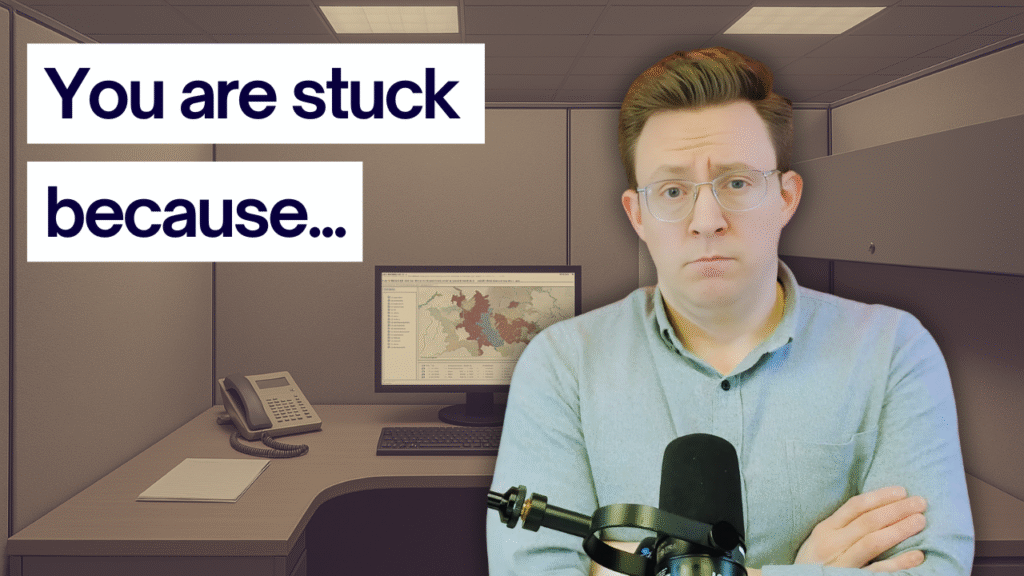Why Your GIS Career Feels Stuck (And How to Break Through)

Do you feel like your GIS career has stalled even though you are putting in the effort, learning new tools, and taking on more responsibility? You are not alone. Many early and mid-career GIS professionals reach a point where advancement feels slow, uncertain, or entirely out of reach.
However, this is not a sign that you are doing anything wrong. In fact, these challenges are very common in the geospatial field. Once you recognize what is holding you back, you can take clear and strategic steps to move forward.
There are three major reasons GIS careers get stuck. More importantly, there are concrete actions you can take to accelerate again.
1. The Technician Trap
Most GIS careers begin in project-based roles such as GIS Analyst or GIS Technician. While these roles are valuable, they often tie your contribution directly to the completion of discrete tasks. When the project ends, the perceived “value” ends with it.
This leads to a narrow focus:
- You carry out technical work rather than influence strategic decisions.
- You produce outputs but have limited visibility into how they impact organizational priorities.
To grow beyond this stage, GIS professionals must move from execution to direction. That means connecting your work to broader organizational goals and clearly communicating how geospatial insights influence outcomes.
2. Focusing on Maps Instead of Outcomes
Many GIS professionals highlight deliverables such as maps, dashboards, or automated scripts. These are important, but the real value lies in what those deliverables enabled.
There is a meaningful difference between:
- “I built a zoning map”
- “I created a zoning map that supported the approval of three new community developments”
The second statement communicates:
- The purpose of the work
- The problem it solved
- The value delivered to others
As the transcript notes, professionals should shift from a portfolio of deliverables to a portfolio of solutions.
This shift brings clarity to hiring managers and leadership. It shows not just what you did, but why it mattered.
3. No Clear Career Path or Identity
Many organizations offer titles like Analyst I, Analyst II, or Senior Analyst, but the work remains largely the same. That makes it difficult to measure growth or understand the next meaningful step.
The key here is intentional specialization.
Ask yourself two questions:
- What technical work do I genuinely enjoy doing?
- Who benefits the most from that work, and how?
For example:
- If you enjoy scripting and data workflows, you might specialize toward geospatial data engineering.
- If you prefer analysis and modeling, you might position yourself toward geospatial data science.
- If you love cartography and communication, you might focus on spatial visualization and storytelling.
When you articulate a clear specialty and the value it delivers, you become easier to hire, promote, or assign to strategic initiatives.
How to Get Unstuck: A Practical Framework
Here is a set of concrete actions you can begin this month that combine skills, visibility, and strategic positioning:
Step 1: Identify a Specific Problem to Solve
Look inside your current role and seek inefficiencies, manual processes, or knowledge gaps where spatial data could help.
Example practical outcomes:
- Reduce a weekly report process from hours to minutes through automation.
- Create a data pipeline that ensures a team always has access to updated information.
- Deliver an analysis that improves allocation decisions or resource planning.
Step 2: Build a Solution and Track the Impact
Measure time saved, cost reduced, or accuracy improved. Convert outcomes into language business leaders understand.
For example:
- “Improved wildfire risk model accuracy by 15 percent, enabling better prioritization of high-risk zones.”
- “Reduced map delivery turnaround time by 75 percent, supporting faster field operations.”
Step 3: Communicate That Success
Present your work not only as a technical achievement, but as a contributor to organizational objectives.
You can apply this through:
- A revised resume focused on value delivered
- Updated LinkedIn profile showing strategic specialization
- Internal presentations or documentation demonstrating outcomes
Career growth is as much about how your work is understood as it is about the work itself.
Where This Leads
When you consistently:
- Solve relevant problems
- Demonstrate measurable outcomes
- Clearly communicate the value you create
You shift from being seen as:
- A map maker to a decision maker
- A technician to a strategic contributor
- A support role to a growth driver
This is how careers accelerate and opportunities expand.
You Can Move Forward from Here
Feeling stuck is often a signal that you are ready for a new phase of growth. You have already built the foundation. Now it is time to align your work with the value organizations need and clearly communicate how you deliver that value.
Your GIS skills can create tremendous impact. When you show that impact, advancement becomes far more achievable.
If you would like guidance on developing both the technical and strategic skills required for modern spatial roles, I built the Career Compass to support professionals exactly at this stage in their career. It combines hands-on skill building with positioning and portfolio development aligned to today’s job market.
And if this article inspired you, I would love to hear how you are starting to reshape your GIS positioning and the kinds of problems you want to help solve.
The next step in your career is not a job title. It is clarity in the value you deliver.
